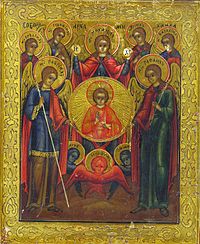Seven Archangels: Difference between revisions
m Robot: Adding ro:Șapte Arhangheli |
|||
| Line 28: | Line 28: | ||
There may be an etymological relationship between the three "disputed" Archangel names, and they may in fact be equivalent. |
There may be an etymological relationship between the three "disputed" Archangel names, and they may in fact be equivalent. |
||
j.p. love |
|||
==See also== |
==See also== |
||
Revision as of 23:53, 11 August 2012
It has been suggested that Saint Archangel be merged into this article. (Discuss) Proposed since November 2009. |

The earliest reference to a system of seven archangels as a group appears to be in Enoch I (the Book of Enoch) which is not part of the Jewish Canon but is prevalent in the Judeo tradition, where they are named as Gabriel, Michael, Raphael, Uriel, Raguel, Remiel and Saraqael. While this book today is non-canonical in most Christian Churches, it was explicitly quoted in the New Testament (Letter of Jude 1:14-15) and by many of the early Church Fathers. The Ethiopian Orthodox Church to this day regards it to be canonical.
Early and Medieval Church Angelology
In the late 5th to early 6th century, Pseudo-Dionysius gives them as Michael, Gabriel, Raphael, Uriel, Chamuel, Jophiel, and Zadkiel.
The earliest Christian mention is by Pope Saint Gregory I who lists them as Gabriel, Michael, Raphael, Uriel (or Anael), Simiel, Oriphiel and Zachariel. A later reference to seven archangels would appear in an 8th or 9th century talisman attributed to Auriolus, a "servant of God" in north-western Spain. He issues a prayer to "all you patriarchs Michael, Gabriel, Cecitiel, Oriel, Raphael, Ananiel, Marmoniel, who hold the clouds in your hands".[1]
Archangels in current church traditions
The Eastern Orthodoxy tradition venerates Gabriel, Michael, Raphael, Uriel, Selaphiel, Jegudiel, and Barachiel.
Another variation lists them corresponding to the days of the week as: St Michael (Sunday), St Gabriel (Monday), St Raphael (Tuesday), St Uriel (Wednesday), St Sealtiel (Thursday), St Jegudiel, (Friday), and St Barachiel (Saturday).
According to Rudolf Steiner, four important archangels also display periodic spiritual activity over the seasons: Spring is Raphael, Summer is Uriel, Autumn is Michael, and Winter is Gabriel.[2]
In the Coptic Orthodox tradition the seven archangels are named as Gabriel, Michael, Raphael, Suriel, Zadakiel, Sarathiel and Aniel.
The Roman Catholic Church only explicitly names 3 archangels: Gabriel, Michael and Raphael. Gabriel and Michael are the only two named in the new testament of the Bible. However, the same passages that name Raphael in the book of Tobit also states that he is "one of the seven who stand before God." The other names can be derived from traditional Jewish teaching.
In Anglican and Episcopal tradition, there are three or four archangels in its calendar for September 29 feast for St. Michael and All Angels (also called Michaelmas: namely Gabriel, Michael and Raphael,[3] and often, Uriel.[4][5][6][7][8]
Other views
In the more modern angelology, different sources disagree on the names and identities of the seven archangels. In the Book of Enoch, Remiel is also described as one of the leaders of the 200 Grigori, the fallen angels. Various occult systems associate each archangel with one of the traditional seven "luminaries" — the Sun, Moon, Mars, Mercury, Jupiter, Venus, and Saturn — but there is disagreement as to which archangel corresponds to which body.
The seven archangels figure in some systems of ritual magic, each archangel bearing a specific seal.
There may be an etymological relationship between the three "disputed" Archangel names, and they may in fact be equivalent. j.p. love
See also
- Amesha Spentas
- Hierarchy of angels
- Olympian spirits
- Saint Archangel
- Seven princes of Hell - the Archangel's counter-point in Hell
- Shoulder angels
- Yazata
Notes and references
- ^ Julia M.H. Smith, Europe After Rome: A New Cultural History 500-1000. Oxford: Oxford University Press, 2005. Page 77
- ^ The encyclopedia of angels, p.45, by Rosemary Guiley, Infobase Publishing, 2004.
- ^ Oremus.org website. Retrieved September 15, 2008.
- ^ Saint Uriel Church website patron Saint web page. Retrieved September 15, 2008.
- ^ Lesser Feasts and Fasts, p. 380.
- ^ Anglican.org website Michaelmas page. Retrieved September 15, 2008.
- ^ St. George's Lennoxville website, What Are Anglicans, Anyway? page. Retrieved September 15, 2008.
- ^ Christ Church Eureka website, September Feasts page. Retrieved September 15, 2008.
- Godwin, Malcolm. Angels: An Endangered Species, New York: Simon & Schuster 1990/ London: Boxtree 1993.
- Benor, Daniel J. Healing Research, Volume III — Personal Spirituality: Science, Spirit and the Eternal Soul, Bellmawr, NJ: Wholistic Healing Publications 2006
